| Article ID | Journal | Published Year | Pages | File Type |
|---|---|---|---|---|
| 7321658 | Neuropsychologia | 2014 | 9 Pages |
Abstract
It is widely accepted that brain maturation from adolescence to adulthood contributes to substantial behavioural changes. Despite this, however, knowledge of the precise mechanisms is still sparse. We used fMRI to investigate developmental differences between healthy adolescents (age range 14-15) and adults (age range 20-39) in feedback-related decision making using a probabilistic reversal learning task. Conventionally groups are compared based on continuous values of blood oxygen level dependent (BOLD) percentage signal change. In contrast, we transformed these values into discrete states and used the pattern of these states to compare groups. We focused our analysis on anterior cingulate cortex (ACC), ventral striatum (VS) and ventromedial prefrontal cortex (vmPFC) as their functions have been shown to be critical in feedback related decision making. Discretisation of continuous BOLD values revealed differential patterns of activity as compared to conventional statistical methods. Results showed differential representation of feedback and decision in ACC and vmPFC between adolescents and adults but no difference in VS. We argue that the pattern of activity of ACC, vmPFC and VS in adolescents resulted in several drawbacks in decision making such as redundant and imprecise representation of decision and subsequently poorer performance in terms of the number of system changes (change of contingencies). This method can be effectively used to infer group differences from within-group analysis rather than studying the differences by direct between-group comparisons.
Keywords
Related Topics
Life Sciences
Neuroscience
Behavioral Neuroscience
Authors
Amir Homayoun Javadi, Dirk H.K. Schmidt, Michael N. Smolka,
